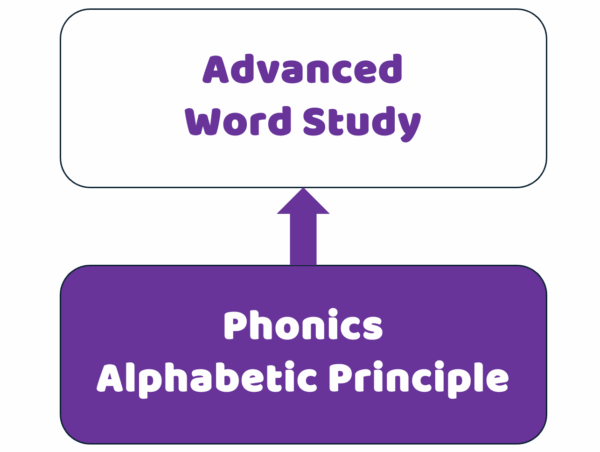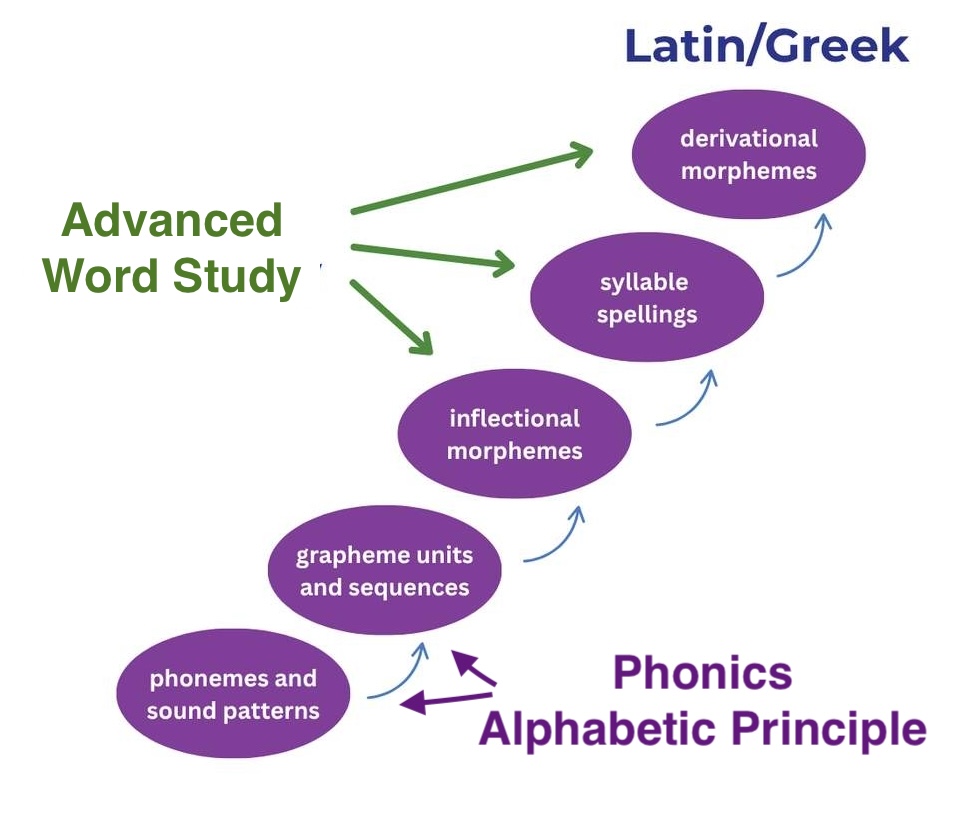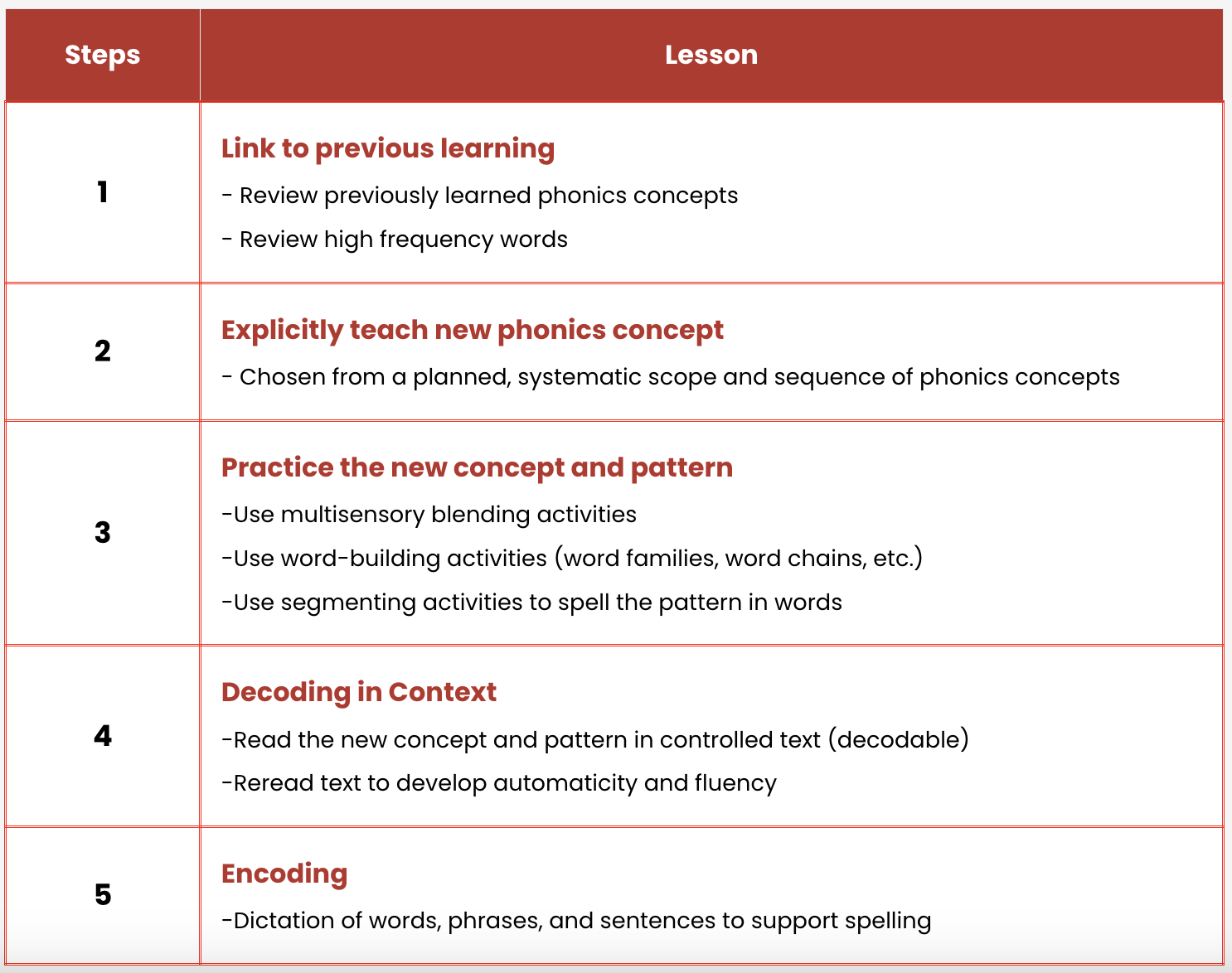Phonics and Advanced Word Study: What’s the Difference?

Phonics and advanced word study (sometimes referred to as advanced phonics) are both essential components of reading instruction, focusing on enhancing students’ understanding of word structures, improving decoding skills, and strengthening spelling abilities. Both types of instruction focus on how words can be broken down into parts, which can then be combined to read and spell. However, they differ in terms of focus, complexity, and the stage of development at which they are typically taught.

As illustrated in the progression above (Moats), the alphabetic principle and phonics instruction, typically introduced in the early grades (K–2), focus on foundational reading skills. They emphasize the relationship between letters and their corresponding sounds, such as consonants, blends, digraphs, and simple word patterns (e.g., consonant-vowel-consonant, CVCe). The goal of beginning phonics instruction is to teach students how to combine phonemic awareness with knowledge of letter-sound correspondences to decode (read) and encode (spell) basic words, such as red, slot, chip, mate, rabbit, inside, and tiptop.
Advanced word study, on the other hand, is typically introduced and practiced in grades 3–5, building upon a phonics foundation. It focuses on more complex word structures, including syllables and meaningful word units (morphemes) like prefixes, suffixes, and Latin and Greek roots, to read and spell multisyllabic words, such as disrupted, conventional, and telescope. Advanced word study requires students to have a solid grasp of phonics before moving on to more complex word analysis. Advanced word study also emphasizes word meaning and vocabulary development, as students use their knowledge of morphemes to help determine the meaning of unfamiliar words.
It is important to note that the suggested grade levels apply to the typical, grade-level development of reading skills. Some older, struggling readers may need intervention that addresses both phonics and advanced word study.
Structured Literacy Instruction
A structured literacy approach is beneficial for teaching both phonics and advanced word study (see my post What is Structured Literacy Instruction?). Research shows that structured literacy is effective for all students and essential for students who struggle with reading (Cowen, 2016). It involves systematic, explicit instruction that integrates listening, speaking, reading, and writing, and includes instruction for multiple levels of language: phonology, orthography, syntax, morphology, and semantics (see my post Levels of Language).
More About the Alphabetic Principle and Phonics Instruction
The alphabetic principle is the understanding that letters and letter patterns represent the sounds of spoken language. When students grasp this principle, they develop grapho-phonemic awareness, which is critical for learning to decode and spell words in English, which uses an alphabetic writing system.
Phonics instruction helps students apply the alphabetic principle by teaching them the relationships between graphemes and phonemes. It involves learning how the 26 letters of the alphabet and their combinations represent the 44 phonemes (sounds) in English. Understanding predictable sound-symbol relationships allows students to read both familiar and unfamiliar words and supports the development of reading fluency. Phonemic awareness, the ability to identify, blend, segment, and manipulate individual phonemes in spoken words, is essential for developing phonics skills. Students rely on phonemic awareness to link the sounds they hear to the letters they see, enabling them to blend those sounds and decode words. (See my post Developing Phonemic Awareness Using Letters .)
Phonics instruction should introduce a few letter-sound correspondences at a time. The simplest phonics concepts involve one-to-one sound-letter correspondences—where one letter represents one sound—and focus on the most common sounds. While students will eventually learn multiple spellings for English phonemes, it is best to focus initially on the most frequently used consonants (b /b/, c /k/, d /d/, f /f/, g /g/, h /h/, k /k/, l /l/, m /m/, n /n/, p /p/, s /s/, t /t/) and short vowels.
Once students have learned a few consonants and short vowels, they can begin blending sounds to read and spell simple words, even if they haven’t yet mastered all letter-sound correspondences in the alphabet. For example:
- Using the short vowel i and the consonants t, s, f, m, l, h, d, students can read: it, if, sit, fit, lit, hit, lid, did, hid, dig, fig, gig
- Using the short vowel a and the same consonants, students can read: at, sat, fat, hat, mat, sad, dad, lad, fad, mad, had, tag, lag, gas, ad
Phonics Scope and Sequence
A phonics scope and sequence typically progresses from basic to advanced concepts, including short vowels, consonant digraphs and blends, long vowel sounds, vowel pairs, r-controlled vowels, silent letters, and multisyllabic words with prefixes and suffixes.
While there is no universally agreed-upon phonics scope and sequence, any logical sequence begins with the most basic phonics concepts and gradually introduces more complex ones, building on prior knowledge (Carreker, 2011). These sequences may vary by program. If you are using an explicit, systematic phonics program, it is best to follow its recommended sequence. If you are not using a program, or if your program lacks a clearly structured sequence, a suggested phonics scope and sequence is provided in a previous post, Systematic Phonics Scope and Sequence. This scope and sequence covers concepts typically taught by the end of grade 3 and can also guide intervention for older students.
Phonics Lesson Plan
Phonics instruction is most effective when delivered through a consistent, structured routine. The sample routine shown below from the Keys to Beginning Reading book and professional development course outlines the steps for introducing and practicing new phonics concepts. These steps may occur within a single lesson or span multiple lessons, depending on the phonics program being used.

More About Advanced Word Study Instruction
Advanced word study focuses on reading and spelling multisyllabic words by using word analysis to identify syllables and morphemes (meaningful word parts such as prefixes, suffixes, and roots). The ability to decode longer words is critical, especially considering that up to 90% of the words students in grade 5 and up encounter in texts are multisyllabic (Baayen, Piepenbrock, & Gullikers, 1995). In addition to using morphemes to decode multisyllabic words, knowledge of morphemes can be used to help determine the meaning of unfamiliar words. For example, knowing that bi means “two” and sect means “cut” helps determine that bisect means “to cut in two” (see my post Using Morphology to Teach Vocabulary).
Using Word Analysis to Read Multisyllabic Words
Proficient readers integrate three key word analysis strategies when decoding unfamiliar multisyllabic words:
- Identifying meaningful units (morphemes)
- Identifying syllables
- Flexing the pronunciation of vowel sounds
Instruction for word analysis can begin as early as grade 3, be emphasized in grades 4 and 5, and be practiced with increasingly longer and more complex words in middle school grades.
Syllables: A syllable is a unit of pronunciation that contains one vowel sound, possibly accompanied by consonant sounds before or after the vowel. A syllable can constitute an entire word or just part of one. All words have at least one syllable. There are six primary syllable types: closed, open, vowel-consonant-e, vowel team, vowel-r, and consonant-le.
Morphemes: A morpheme is a meaningful word part (prefix, root, or suffix). More than half of English words contain more than one morpheme (Nagy & Anderson, 1984). Latin-based words make up the majority of academic vocabulary found in upper-grade texts, while Greek-based words—comprising about 10% of English words—are often encountered in science and math textbooks (National Institute for Literacy, 2007; Carlisle, 2007; Kearns, 2015). Latin-based words typically combine a root with a prefix and/or suffix (e.g., informing, conventional, disrupted). In contrast, Greek-based words often combine multiple roots (e.g., chromosome, telescope, atmosphere).
Flexing Vowel Sounds: Vowels and vowel combinations can be pronounced in different ways—long, short, or as the schwa (a muffled sound, often like a short “u”). Once students break a word into syllables or morphemes, they may need to experiment with different vowel pronunciations to find the one that makes a recognizable word. This strategy is known as “flexing” the vowel sound. Students flex vowel sounds until they produce a familiar, real word.
A Routine for Multisyllabic Words
Explicit routines that support word analysis have been shown to be effective in promoting word knowledge growth (Jones et al., 2019; Vaughn et al., 2022). Review the example below of a word analysis routine (Sedita, 2025, adapted from the Pennsylvania Training and Technical Assistance Network, 2021, and Regional Educational Laboratory at Florida State University, 2016).
Word Analysis Routine:
- Identify the word parts and vowels.
- Circle the prefixes and suffixes.
- Underline the vowels that represent syllables in the remaining parts of the word.
- Say the different parts of the word.
- Say each part of the word by pronouncing prefixes, each syllable in the root, and suffixes.
- Blend the parts together and say them again faster to make a whole word.
- Flex the vowel sound(s) if necessary to make the word sound like a word you know.
- Repeat the full sentence in which the word appears to make sure it makes sense.
Older Students with Reading Difficulties
Many older students who struggle with reading have difficulty decoding multisyllabic words. While they may have acquired basic phonics skills for reading one- and two-syllable words, they have not yet developed fluency with longer words, hindering their ability to access and comprehend grade-level texts. Research supports explicit instruction in word analysis, including syllabication strategies and morphological awareness, as an effective intervention—particularly for English learners and students with learning disabilities (Thomas). Some older students with significant gaps in phonics knowledge may also need intervention instruction for basic phonics skills (Vaughn et al., 2022).
Conclusion
While both phonics and advanced word study are integral to literacy instruction, they differ in the complexity and focus of their content. Phonics provides the essential building blocks for reading and spelling, while advanced word study expands on these skills, teaching students more complex word structures and word analysis for multisyllabic words.
References:
- Baayen, R. H., Piepenbrock, R., & Gulikers, L. (1995). The CELEX Lexical Database [CD-ROM]. Linguistic Data Consortium, University of Pennsylvania.
- Carlisle, J. F. (2007). Fostering morphological processing, vocabulary development, and reading comprehension. In R. K. Wagner, A. E. Muse, & K. R. Tannenbaum (Eds.), Vocabulary acquisition: Implications for reading comprehension. Guilford Press
- Cowan, C. (2016). What is structured literacy? International Dyslexia Society. https://dyslexiaida.org/what-is-structured-literacy/
- Carreker, S. (2011). Teaching reading: Accurate decoding. In J. R. Birsh (Ed.), Multisensory teaching of basic language skills (3rd ed., pp. 203-216). Baltimore, MD: Brookes.
- Jones, S. M., LaRusso, M., Kim, J., Yeon Kim, H., Selman, R., Uccelli, P., Barnes, S. P., Donovan, S., & Snow, C. (2019). Experimental effects of word generation on vocabulary, academic language, perspective taking, and reading comprehension in high-poverty schools. Journal of Research on Educational Effectiveness, 12(3), 448–483.
- Kearns, D. M. (2015). How elementary-age children read polysyllabic polymorphemic words. Journal of Educational Psychology, 107, 364–390. https://psycnet.apa.org/record/2014-44659-001
- Moats, L. C. (n.d.-b). Teaching spelling using a structured literacy approach. PowerPoint presentation, sponsored by CORE (Consortium for Reaching Excellence in Education).
- Nagy, W. E., & Anderson, R. C. (1984). How many words are there in printed school English? Reading Research Quarterly, 19, 304–330.
- National Institute for Literacy. (2007). What content-area teachers should know about adolescent literacy. National Institute of Child Health and Human Development.
- Pennsylvania Training and Technical Assistance Network. (2021). Reading big words. PATTAN. https://www.youtube.com/watch?v=7D-pKMT9WLY
- Regional Educational Laboratory at Florida State University (2016). Word analysis strategy. Institute of Education Sciences. https://www.youtube.com/watch?v=RmKY3RFmajk&list=PLVHqsnePfULo3KA8dspX6558xwZxVr2rB&index=30
- Sedita, J. (2025). Keys to Adolescent Literacy. Keys to Literacy.
- Thomas, G. (n.d.) Turning the page to secondary literacy: Tested practices for schools to identify gaps and implement interventions for secondary readers. Marshall Street. https://www.marshall.org/initiative/marshall-colab/research-to-impact/literacy/
- Vaughn, S., Gersten, R., Dimino, J., Taylor, M. J., Newman-Gonchar, R., Krowka, S., Kieffer, M. J., McKeown, M., Reed, D., Sanchez, M., St. Martin, K., Wexler, J., Morgan, S., Yañez, A., & Jayanthi, M. (2022). Providing Reading Interventions for Students in Grades 4–9 (WWC 2022007). National Center for Education Evaluation and Regional Assistance (NCEE), Institute of Education Sciences, U.S. Department of Education.

 Joan Sedita is the founder of Keys to Literacy and author of the Keys to Literacy professional development programs. She is an experienced educator, nationally recognized speaker and teacher trainer. She has worked for over 35 years in the literacy education field and has presented to thousands of teachers and related professionals at schools, colleges, clinics, and professional conferences.
Joan Sedita is the founder of Keys to Literacy and author of the Keys to Literacy professional development programs. She is an experienced educator, nationally recognized speaker and teacher trainer. She has worked for over 35 years in the literacy education field and has presented to thousands of teachers and related professionals at schools, colleges, clinics, and professional conferences.
A fascinating and easy-to-read/understand article! I’m going to save it. Also, I’ll refer to the links included in the article, as I’m sure they’ll be equally informative.